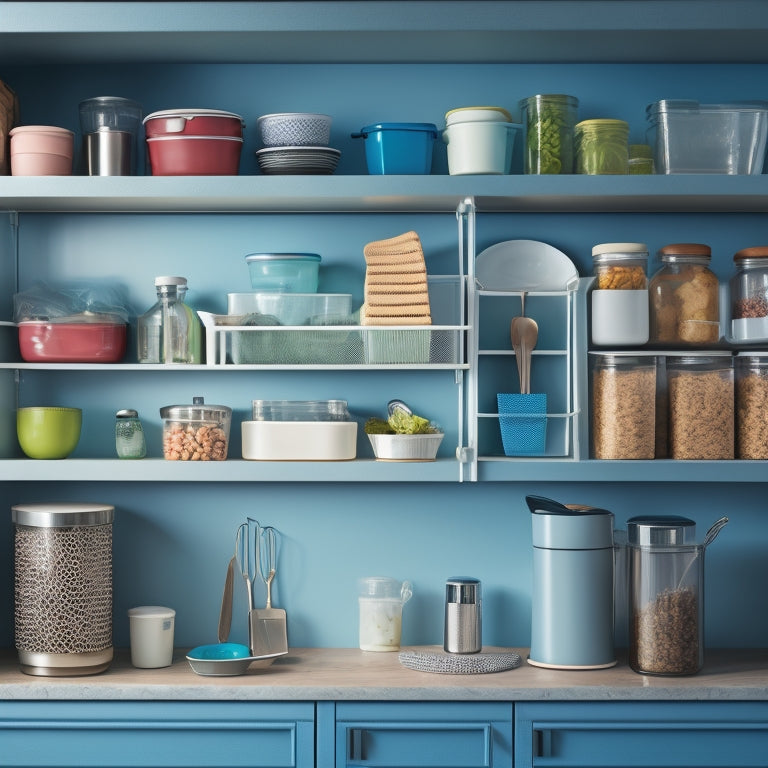
Transforming Plastic Ware Chaos: Practical Organizing Tips
Share
Transform cluttered plastic ware storage areas into organized, functional spaces by starting with a thorough purge and categorization of containers. Sort them by size, assess their condition, and identify orphaned or damaged ones. Utilize space-saving solutions like nesting containers and shelving units to optimize storage space. Store lids separately and categorize containers by size, labeling bins for easy access. By implementing these strategies, you'll reduce stress, increase productivity, and create a relaxed kitchen environment. With a few simple tweaks, you can open up a more streamlined and efficient storage system, and discover even more innovative solutions to maintain your newfound organization.
Key Takeaways
• Clear out storage areas completely to assess and categorize containers, identifying orphaned or damaged ones and optimizing storage space.
• Utilize space-saving solutions like nesting containers, vertical shelving, and separate lid storage to maximize storage capacity and reduce clutter.
• Implement a categorization system by size, labeling bins and promoting a sense of control and calm in the kitchen environment.
• Regularly clean and inspect plastic storage bins, decluttering and purging unused items to maintain organized and functional storage solutions.
• Consider installing shelving units that reach the ceiling and explore hidden storage options to triple storage capacity and create a clutter-free kitchen.
Purge and Categorize Containers
Before organizing your plastic ware collection, clear out the storage area completely to gain a thorough understanding of what you have, and begin by removing all containers, including those that have been stored away for years, to assess their condition and relevance.
This essential step allows you to declutter efficiently and identify orphaned or damaged containers that can be discarded.
Next, sort your containers by size, categorizing them into small, medium, and large groups. This will help you visualize the balance of your collection and determine the best number of containers to keep for each size.
Optimize Storage Space Efficiently
With your containers purged and categorized, it's now time to design a storage system that maximizes space and accessibility.
To optimize storage space efficiently, consider space-saving solutions such as nesting containers, utilizing vertical space with shelving units, and storing lids separately in a bin for easy access.
Implement efficient organization by categorizing containers by size and storing them in labeled bins. This will enable you to quickly locate the container you need, reducing clutter and increasing productivity.
Benefits of Organized Plastic Ware
By implementing a structured plastic ware system, homeowners can enjoy a variety of benefits that go beyond just a clutter-free kitchen. This includes reduced stress, increased productivity, and improved overall well-being.
An organized system leads to enhanced efficiency. Containers are easily accessible and visible, saving time and effort when preparing meals. Improved visibility also ensures that containers are not misplaced or forgotten, reducing the likelihood of duplicate purchases.
Additionally, an organized system promotes a sense of control and calm, allowing homeowners to focus on more important aspects of their lives. By streamlining their plastic ware collection, individuals can enjoy a more relaxed and organized kitchen environment.
Ultimately, this contributes to a more balanced and harmonious lifestyle.
Maximizing Vertical Storage Space
Five shelving units, strategically positioned along the kitchen walls, can effectively triple the storage capacity of the room, providing ample space for plastic ware containers and other kitchen essentials.
By utilizing wall space and maximizing vertical storage, you can create a more organized and clutter-free kitchen. Consider installing shelves or storage units that go up to the ceiling to make the most of available space.
Additionally, explore hidden storage options, such as under bed solutions, to store infrequently used items. This will help keep your kitchen counters and floors clear, creating a more streamlined and efficient cooking environment.
Easy Maintenance and Upkeep Tips
Its sturdy and long-lasting nature notwithstanding, a well-kept plastic storage bin requires regular cleaning and inspection to guarantee its peak performance and prolong its lifespan. For quick cleaning, wipe down bins with a damp cloth or mild soap solution, and allow them to air dry completely before stacking. This prevents moisture buildup and preserves the bin's integrity.
Regularly declutter and purge unused items to prevent overcrowding and maintain easy access to stored containers. Implementing these simple maintenance tips will optimize your storage solutions, keeping your plastic ware collection organized and functional.
Sustainable Storage Alternatives Found
One sustainable alternative to traditional plastic storage bins is reusable fabric storage bins. They offer a stylish and eco-friendly solution for organizing plastic ware containers. These bins are made from durable, washable materials and come in a variety of sizes and styles to fit your storage needs.
Another eco-friendly option is repurposing cardboard boxes or wooden crates for storage. Upcycling old containers or using biodegradable storage solutions can also reduce waste and minimize environmental impact.
Creative Repurposing Ideas Uncovered
Beyond traditional storage uses, repurposed containers can be creatively transformed into functional items that add a touch of personality to your kitchen or dining space. Explore innovative upcycling projects that breathe new life into old containers, such as turning them into planters, vases, or unique decorative pieces.
These eco-friendly solutions not only reduce waste but also add a personal touch to your space. Unconventional storage hacks can also be achieved by repurposing containers as desk organizers, candle holders, or even wall-mounted shelves. Find repurposing inspiration online or experiment with different materials and designs to create one-of-a-kind pieces.
Frequently Asked Questions
How Often Should I Reorganize My Plastic Ware Storage System?
To sustain a clutter-free storage system, reorganize every 6-12 months, guaranteeing regular decluttering and categorization of containers, and performing routine maintenance tasks, such as wiping down bins and checking for damage, to achieve peak storage functionality.
Can I Use Adhesive Hooks to Hang Plastic Storage Bins?
According to the National Association of Professional Organizers, 64% of Americans struggle with clutter management. To optimize storage, consider using adhesive hooks to hang plastic bins, providing a convenient hanging solution for organizing containers and maximizing vertical space.
Are Glass Containers Better Than Plastic for Food Storage?
When considering glass vs plastic for food storage, prioritize food safety by opting for glass containers, which are non-porous, resistant to chemical leaching, and easier to clean, ensuring a healthier and more sustainable storage solution.
Can I Store Plastic Ware Containers in a Humid Environment?
Did you know that 80% of people experience frustration when dealing with cluttered storage spaces? To avoid this, when storing plastic ware containers in a humid environment, consider using waterproof bins or airtight containers to prevent moisture buildup and maintain container integrity.
Are Fabric Storage Bins Suitable for Storing Heavy Items?
When considering fabric storage bins for heavy items, prioritize space optimization by selecting sturdy, reinforced bins with durable handles, ensuring they can support the weight without compromising storage solutions or fabric integrity.
Related Posts
-

Baked Kale
Kale is one of the most healthiest and nutritious plant foods in existence and is delicious! Try these baked kale re...
-

Healthy Breakfast Snacks for Mornings on the Run
We know that when you are on the run it is difficult to cook breakfast and even worse to eat healthy! That’s why we f...

